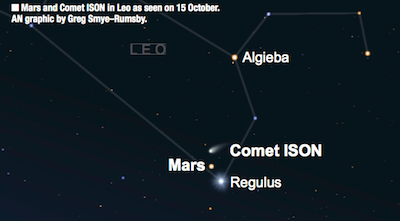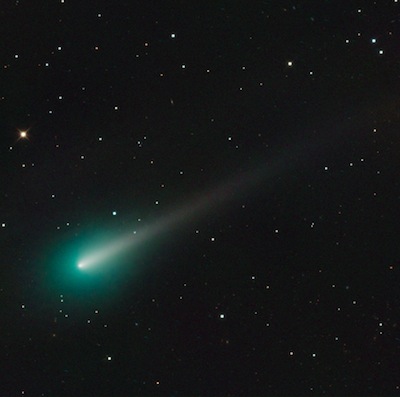
ISON, Mars and Regulus converge in the sky
BY MARK ARMSTRONG
ASTRONOMY NOW
Posted: 15 October 2013

The planet Mars and comet ISON have been on a converging eastern path in Leo during October and they are at their closest now, with the significant added bonus of Leo's luminary, first magnitude Regulus, in the same neighbourhood in the sky.

The red planet and ISON are a degree apart in the pre-dawn hours of 16 October, with ISON to the north of Mars and Regulus a degree to the south-south-west. Astronomy Now's Peter Grego reports that all three will be visible within the field of big 25 x 100 binoculars and, say, an 200-mm SCT with a focal reducer and a wide-angle, long focal length eyepiece.
This spectacular grouping will be visible in the eastern sky and will require getting out of bed around 4.30am (BST), by which time they all will have almost obtained an altitude of 20 degrees above the horizon. An unobstructed horizon will be required too. At this time the Sun is about three hours away from rising (from London) and the sky is astronomically dark and will remain so until 5.30am, with perhaps another 45 minutes of useful darkness available; by the time the morning twilight starts to engulf the scene, the grouping will be a favourable 35 degrees above the horizon. Mars is still a pretty uninspiring naked eye object way off its best, its ruddy disc glowing at magnitude +1.6 and spanning 4.6 arcseconds through the eyepiece.

Credit: Gerald Rhemann
If the seeing allows, using high magnification though a moderate to large scope will show the familiar wedge-shaped Syrtis Major just moving off the Martian disc and Mare Acidalium emerging at the following limb. It will be interesting to compare the brightness and colour of Mars against that of white class-B Regulus, with the later slightly brighter at mag.+1.36. ISON is now a 10th magnitude object sporting a nice tail about a quarter of a degree in length pointing away to the WNW and a greenish coma about three arcminutes across.
As October progresses Mars and ISON will draw away from Regulus on their easterly journey through Leo; they will be at their closest on 18-19 October with their separation under a degree. The comet's ever-increasing speed takes it pass Mars as it passes 1.5 degrees south of the great Leo galaxies M95 and M96. By the end of October ISON could brighten to be a seventh magnitude object. It lies less than a degree east of chi Leonis (mag. +4.6) and is almost 30 degrees up at 5am, the end of the astronomical night. Mars rises at 1.15am and is 33 degrees up by 5am.
The comet is similarly placed across America; from latitudes of New York about an hour before sunrise it gets 38 degrees up mid month falling to 36 degrees at the end. Further south from Houston latitudes ISON holds station around 40 degrees up from mid month. At the end of October Mars rises at 1.30am from New York and is 20 degree above the horizon by 4.15am EDT(4.45am CDT from Houston).
|



